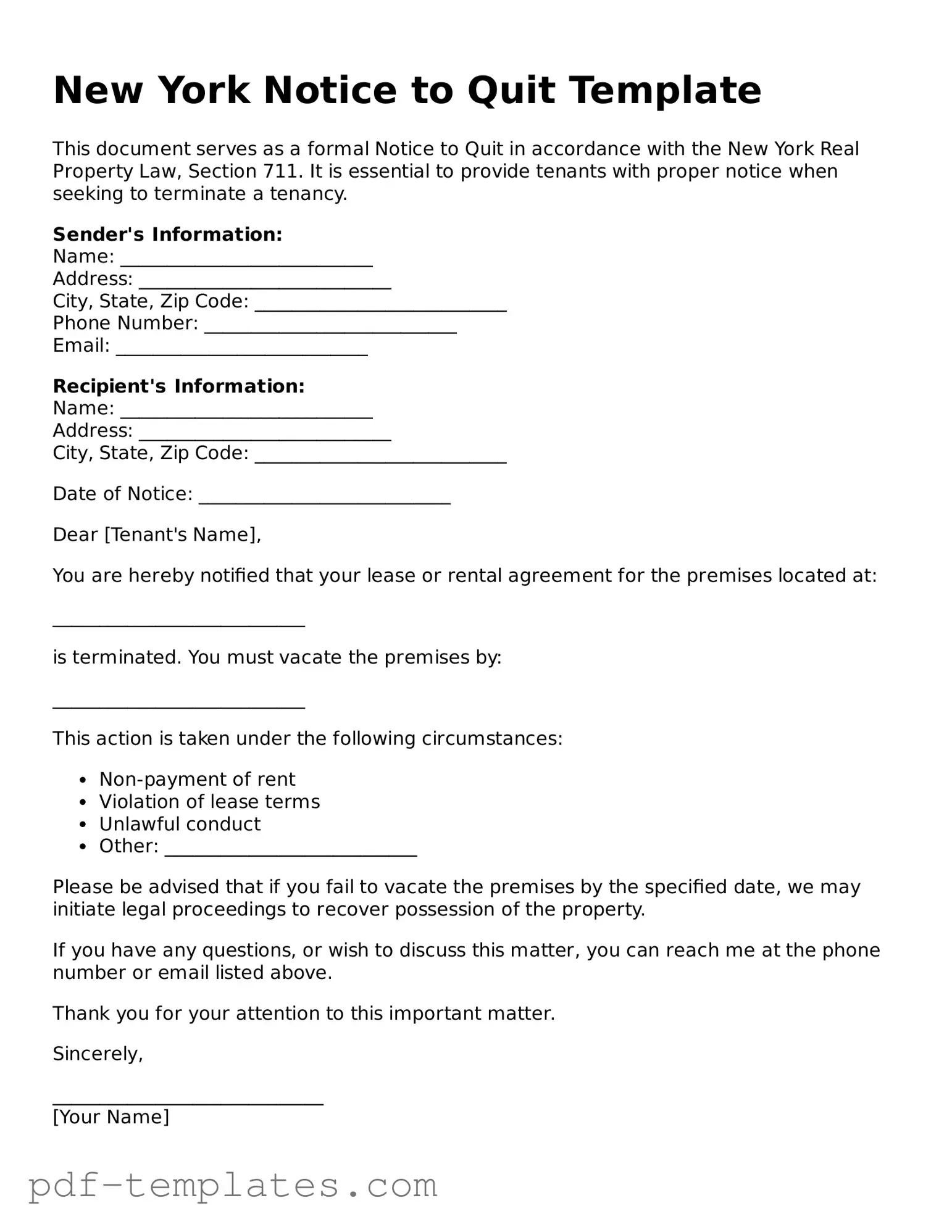The New York Notice to Quit form shares similarities with the Eviction Notice. Both documents serve as formal notifications to tenants regarding their lease violations or failure to pay rent. An Eviction Notice typically outlines the specific reasons for the eviction and the time frame the tenant has to vacate the property. Like the Notice to Quit, it is essential for landlords to follow state laws in delivering this notice to ensure it is legally binding.
Another document akin to the Notice to Quit is the Lease Termination Letter. This letter is used by landlords or tenants to terminate a lease agreement, often due to mutual consent or the expiration of the lease term. While the Notice to Quit focuses on violations or non-payment, the Lease Termination Letter can be issued without any wrongdoing on either party’s part, signaling the end of the rental relationship.
The Three-Day Notice to Pay Rent or Quit is also similar. This document specifically addresses situations where a tenant has failed to pay rent. It gives the tenant three days to either pay the overdue rent or vacate the premises. Like the Notice to Quit, this notice must adhere to state regulations and is a critical step in the eviction process.
In some cases, the New York Notice to Quit resembles the 30-Day Notice to Quit. This notice is often used when a landlord wishes to terminate a month-to-month rental agreement without cause. Unlike the Notice to Quit, which can be issued for specific violations, the 30-Day Notice provides tenants with a longer time frame to find new housing, emphasizing the need for proper notice in tenancy matters.
The Conditional Notice to Quit is another document that parallels the New York Notice to Quit. This notice is issued when a tenant has committed a lease violation but may have the opportunity to rectify the situation. It outlines the specific breach and gives the tenant a chance to correct it within a designated time frame, similar to how the Notice to Quit may allow for resolution before eviction proceedings begin.
The Notice of Default also shares some characteristics with the Notice to Quit. This document is typically used in mortgage situations rather than rental agreements. It informs the borrower that they are in default on their mortgage payments, similar to how a Notice to Quit informs tenants of their lease violations. Both documents aim to prompt corrective action before further legal steps are taken.
For families considering homeschooling, it’s important to understand the necessary documentation involved, such as the Homeschool Letter of Intent form, which serves as a formal notification to the local school district. This crucial document signals the parents' intent to educate their children outside the traditional school system, establishing a formal beginning to their homeschooling journey and ensuring compliance with state regulations.
The Notice to Remedy is another document that is closely related. This notice is issued when a tenant has violated a specific term of the lease, giving them a chance to fix the issue before further action is taken. Like the Notice to Quit, it serves as a formal communication that outlines the problem and the necessary steps to resolve it.
The Demand for Rent is also similar to the Notice to Quit, particularly in its function. This document is used to formally request overdue rent from a tenant. It serves as a reminder of the tenant's obligations under the lease agreement, similar to how the Notice to Quit alerts tenants to their violations. Both documents aim to address issues before escalating to eviction proceedings.
Lastly, the Notice of Termination is another document that can be likened to the New York Notice to Quit. This notice is often used in various rental situations to inform a tenant that their lease will not be renewed at the end of the term. While it may not necessarily indicate a violation, it serves to formally end the rental agreement, much like the Notice to Quit aims to terminate a tenancy due to specific issues.
